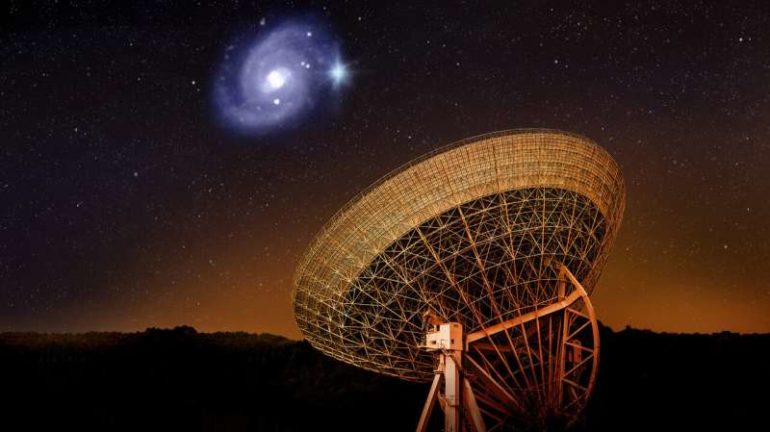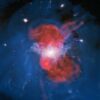Two international teams of astronomers (with significant Dutch involvement) have published two scientific papers with new information about the famous fast radio burst FRB20180916B. In a study published in the Astrophysical Journal Letters, they measured the radiation from the bursts at the lowest possible frequencies. In a study published in Nature Astronomy, they examined the bursts in the greatest possible detail. While the articles provide new information, they also raise new questions.
In 2007, the first fast radio burst (FRB) was discovered. But what exactly causes the bursts is not yet clear. Since 2020, scientists have suspected a connection to strongly magnetic neutron stars called magnetars. One of the best-known fast radio bursts is FRB20180916B. This FRB was discovered in 2018 and is only 500 million light-years away from us in another galaxy. The FRB is the closest so far and has a burst pattern that repeats every 16 days: four days of bursts, 12 days of relative quiet. That predictability makes it an ideal object for researchers to study.
Lowest radio signals ever
An international team of researchers led by Ziggy Pleunis (a graduate of the University of Amsterdam, now McGill University, Montreal, Canada) studied the FRB with the European network of LOFAR radio telescopes. They had tuned the LOFAR antennas to between 110 and 188 MHz. Those are almost the lowest possible frequencies the telescope can receive. They caught 18 bursts. This was unexpected because FRBs usually transmit in high frequencies. FRB20180916B thus breaks the low-frequency record. Incidentally, the researchers suspect that the burst emits radiation in even lower frequencies and will be looking for that in the near future.
Besides records, the observations also provide new insights. The low-level radio emission was quite clean and arrived later than bursts with higher radio emission. Co-author Jason Hessels (Netherlands Institute for Radio Astronomy ASTRON and University of Amsterdam) says, “At different times, we see radio bursts with different radio frequencies. Possibly the FRB is part of a binary star. If so, we would have a different view at different times of where these enormously powerful bursts are generated.”
A team of researchers led by Kenzie Nimmo (ASTRON and University of Amsterdam, the Netherlands) used the European VLBI network of radio telescopes, which includes one of ASTRON’s 12 Westerbork telescopes in Drenthe and the 100-meter Effelsberg telescope in Germany. They looked in the greatest detail ever at the so-called polarized microstructure of the eruptions. The astronomers saw that the burst pattern of FRB20180916B varied from microsecond to microsecond. The most logical explanation for the variation seems to be a “dancing” magnetosphere enveloping a neutron star.
Cosmic flashes come in all different sizes
More information:
LOFAR Detection of 110–188 MHz Emission and Frequency-Dependent Activity from FRB 20180916B. By: Z. Pleunis et al. In: The Astrophysical Journal Letters, 9 April 2021. iopscience.iop.org/article/10. … 847/2041-8213/abec72
Preprint: arxiv.org/abs/2012.08372
Highly polarized microstructure from the repeating FRB 20180916B. By: K. Nimmo et al. In: Nature Astronomy, 22 March 2021. dx.doi.org/10.1038/s41550-021-01321-3
Preprint: arxiv.org/abs/2010.05800
Provided by
Netherlands Research School for Astronomy
Citation:
Famous fast radio burst FRB20180916B just barely lets itself be captured (2021, April 15)
retrieved 15 April 2021
from https://phys.org/news/2021-04-famous-fast-radio-frb20180916b-captured.html
This document is subject to copyright. Apart from any fair dealing for the purpose of private study or research, no
part may be reproduced without the written permission. The content is provided for information purposes only.



